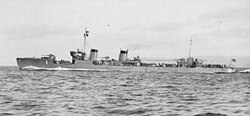Kamikaze (ship, 1922)
|
The kamikaze , 1922
|
||||||||||||||||||
|
||||||||||||||||||
|
||||||||||||||||||
|
||||||||||||||||||
|
||||||||||||||||||
The Kamikaze ( Japanese 神 風 ) was the type ship of a new class , consisting of nine destroyers , which was built for the Japanese Navy from 1921 . The destroyer was one of the few ships in its class to survive the Second World War and was lost in an accident in 1946.
Naming and modifications
Names
The kamikaze was put into service under the name Kiyokaze ( 清風 ). While the last six units of the class were still under construction, the first three ships were renamed.
Conversions
The kamikaze was designed for a crew of 148 men. The Kamikaze , built by Mitsubishi in Nagasaki , was launched on December 28, 1922. The displacement of the approximately one hundred meters long destroyer was about one thousand tons . She was nine meters wide and, when fully loaded with fuel, ammunition, etc., had a draft of 2.89 meters. Two steam turbines , which were coupled directly to the drive shafts without reduction gears and were fed by four oil-fired steam boilers , propelled the ship with an output of 38,528 horsepower up to a speed of 37.5 knots . At medium speed the fuel was sufficient for 2,700 nautical miles. The kamikaze was protected by three-inch belt armor. The armament initially consisted of four 120 mm guns and six 533 mm torpedo tubes. In 1943, one gun was removed to accommodate ten 25mm anti - aircraft machine guns .
Mission history
Battle of the Straits of Malacca
After the destroyer arrived in Singapore on February 22, 1945 , it was assigned as an escort to the heavy cruiser Haguro . On May 9, 1945, both ships left port to go through the Strait of Malacca to the Andaman archipelago . The Japanese had set up a small garrison there two years earlier . Warned of enemy naval forces by their own aircraft, the fleet turned around and was back at its base on the 11th.
On the 14th another attempt was made to break through to the isolated garrison in order to evacuate the troops stationed there. The Allies, informed of their reconnaissance of the operation, deployed two heavy surface combat groups to intercept the two Japanese ships. No less than two battleships , four cruisers, four escort aircraft carriers and ten destroyers were pulled together for this purpose.
Guided by their radar, five Allied destroyers positioned themselves on the night of May 16 to surprise Haguro and Kamikaze with torpedoes in the Strait of Malacca. The Haguro received three torpedo hits and could not be saved. The Kamikaze was not hit, turned and after a brief exchange of fire broke through the ring of the opposing ships. 27 of the destroyer's seamen died as a result of multiple shell hits, 14 were wounded. On the morning of May 17, she returned to the cruiser's sinking site and rescued 320 crew members.
The End
After the end of the war, the kamikaze was disarmed and used as a transporter for the repatriation of Japanese troops that had survived the war scattered in the Pacific region. In June 1946, the Kunashiri , also used to repatriate troops, ran aground near Omaezaki . While trying to support the ship, the kamikaze also ran aground on June 7th . It could not be recovered and was written off as a loss.
Evidence and references
literature
- John Winton: Sink the Haguro: Last Destroyer Action of the Second World War , 1981, Saunders of Toronto Ltd., ISBN 0854221522 (English)
- Joachim Wätzig: The Japanese Fleet - From 1868 to Today , Brandenburgisches Verlagshaus Berlin, 1996, ISBN 3-89488-104-6 (German)
Individual evidence
- ↑ globalsecurity.org, viewed August 1, 2012
- ^ Ashley Jackson, The British Empire and the Second World War , 2006, Hambledon Press, ISBN 978-1852854171 , p. 302
- ^ A b Spencer C. Tucker: World War II at Sea: An Encyclopedia: An Encyclopedia , 2011, ABC-Clio, ISBN 978-1598844573 , p. 337
- ↑ Mission history on combinedfleet.com, viewed on August 1, 2012
